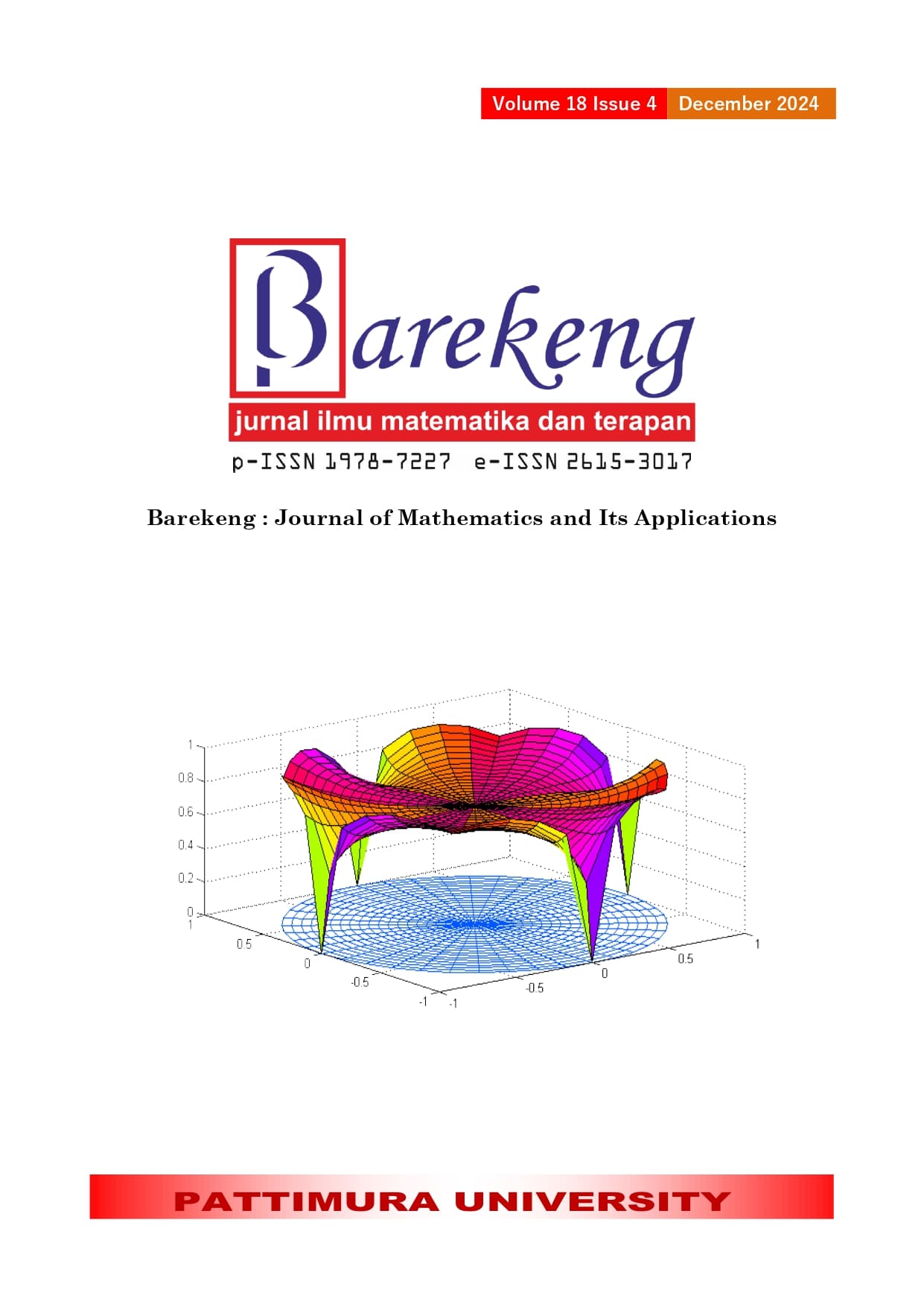MODELING HYPERTENSION DISEASE RISK IN INDONESIA USING MULTIVARIATE ADAPTIVE REGRESSION SPLINE AND BINARY LOGISTIC REGRESSION APPROACHES
Abstract
In the pursuit of the Sustainable Development Goals (SDGs), health-related challenges, especially hypertension, remain a significant global issue. The third goal of the SDGs aims to improve the quality of life and well-being of all individuals, but hypertension is a serious problem that can hinder these goals. Often referred to as the "silent killer" by the World Health Organization (WHO), hypertension is exacerbated by low awareness. Globally, more than 1.28 billion adults suffer from hypertension, with most cases in lower to middle-income countries, including Indonesia. Indonesia has an alarming rate of hypertension incidence, ranking fifth highest in the world. Riset Kesehatan Dasar (Riskesdas) 2023 and the Indonesia Family Life Survey (IFLS) are critical for understanding hypertension risk factors in Indonesia. The IFLS data, obtained from www.rand.org, includes observations from October 2014 to April 2015, totalling 85 observations. Despite being over 10 years old, this dataset was selected because it remains the most recent comprehensive data available from RAND, representing 83% of the Indonesian population. The IFLS is conducted every 7-8 years, with the next wave of data expected soon. Most studies on hypertension globally and in Indonesia use parametric regression methods. However, a research gap exists as no studies have used Multivariate Adaptive Regression Splines (MARS) on IFLS data to analyze hypertension risk factors. This study addresses this gap by comparing binary logit regression and MARS. The analysis shows the Apparent Error Rate (APPER) for MARS is 84.706%, while for binary logistic regression it is 80%, indicating MARS is better at classifying hypertension data in Indonesia. Using MARS offers a novel approach to understanding hypertension risk factors in Indonesia. Despite the data's age, it remains relevant as primary causes and risk factors for hypertension have not changed, making the findings valuable for current health policy and strategies.
Downloads
References
Kementerian Kesehatan, “Tekanan Darah Tinggi (Hipertensi),” 2016. [Online]. Available: https://p2ptm.kemkes.go.id/uploads/2016/10/Tekanan-Darah-Tinggi-Hipertensi.pdf.
World Health Organization, “Hypertension,” World Health Organization, 2023. [Online]. Available: https://www.who.int/news-room/fact-sheets/detail/hypertension.
Kementerian Kesehatan, Hasil Riset Kesehatan Dasar Tahun 2018, Jakarta: Kementerian Kesehatan, 2023.
N. Salsabila, N. Indraswari, B. Sujatmiko, “Gambaran Kebiasaan Merokok di Indonesia Berdasarkan Indonesia Family Life Survey 5 (IFLS 5),” Jurnal Ekonomi Kesehatan Indonesia, vol. 7, p. 1, 2022.
R. Kurniawan & B. Yuniarto , Analisis Regresi, Jakarta: Prenada Media, 2016.
I. Budiantara & I. Wulandari, “Analisis Faktor-Faktor yang Mempengaruhi Persentase Penduduk Miskin dan Pengeluaran Perkapita Makanan di Jawa Timur menggunakan Regresi Nonparametrik Birespon Spline,” Jurnal Sains dan Seni ITS, vol. 3, p. 1, 2014.
M. Y., “Pemodelan Multivariate Adaptive Regression Spline (MARS) Pada Faktor-Faktor yang Mempengaruhi Kemiskinan di Provinsi Maluku dan Maluku Utara,” J Statistika: Jurnal Ilmiah Teori dan Aplikasi Statistika, vol. 13, no. 1, pp. 8-14, 2020.
M. E. Y. Naiborhu, “Analisis Survival dengan Pendekatan Multivariate Adaptive Regression Spline (MARS) Pada Kasus Penyakit Hipertensi,” 2021.
W. Rumaenda, Y. Wulandari, & D. Safitri, “Perbandingan Klasifikasi Penyakit Hipertensi Menggunakan Regresi Logistik Biner dan Algoritma C4. 5 (Studi KasusUPT Puskesmas Ponjong I, Gunungkidul),” Jurnal Gaussian, vol. 5, no. 2, pp. 299-309, 2016.
Cooper & Schindler, Business Research Methods Tenth edition, New York, 2008.
F. J., “Multivariate Adaptive Regression Splines,” The Annals of Statistics, vol. 19, no. 1, pp. 1-67, 1991.
S. Hidayati & B. W. Otok, “Parameter Estimation and Statistical Test in Multivariate Adaptive Generalized Poisson Regression Splines,” IOP Conference Series: Materials Science and Engineering , vol. 546, 2019.
N. A. M. R. Senaviratna & T. M. J. A. Cooray, “Diagnosing Multicollinearity of Logistic Regression Model,” Asian Journal of Probability and Statistics, vol. 5, no. 2, pp. 1-9, 2019.
D. I. Ruspriyanty & A. Sofro, “ Analysis of hypertension disease using logistik and probit regression,” Journal of Physics: Conference Series, vol. 1108, 2018.
Hosmer & Lemeshow, Applied Logistik Regression Second Edition, New York: John Wiley & Sons, Inc, 2000.
D. Belsley, Conditioning diagnostics: Collinearity and weak data in regression, New York: John Wiley & Sons, Inc, 1991.
N. Shrestha, “Detecting Multicollinearity in Regression Analysis,” American Journal of Applied Mathematics and Statistics, vol. 8, pp. 39-42, 2020.
Schwarzer, Vach, & Schumacher, “On the misuses of artificial neural networks for prognostic and diagnostic classification in oncology,” Statistics in medicine, vol. 19, no. 4, pp. 541-561, 2000.
Copyright (c) 2024 Nur Chamidah, Ardana Tegar Hendrawan, Figo Surya Ardiyanto, Martha Sayyida Hammami, Nurul Izzah, Salsabila Niken Hariadi

This work is licensed under a Creative Commons Attribution-ShareAlike 4.0 International License.
Authors who publish with this Journal agree to the following terms:
- Author retain copyright and grant the journal right of first publication with the work simultaneously licensed under a creative commons attribution license that allow others to share the work within an acknowledgement of the work’s authorship and initial publication of this journal.
- Authors are able to enter into separate, additional contractual arrangement for the non-exclusive distribution of the journal’s published version of the work (e.g. acknowledgement of its initial publication in this journal).
- Authors are permitted and encouraged to post their work online (e.g. in institutional repositories or on their websites) prior to and during the submission process, as it can lead to productive exchanges, as well as earlier and greater citation of published works.






1.gif)



